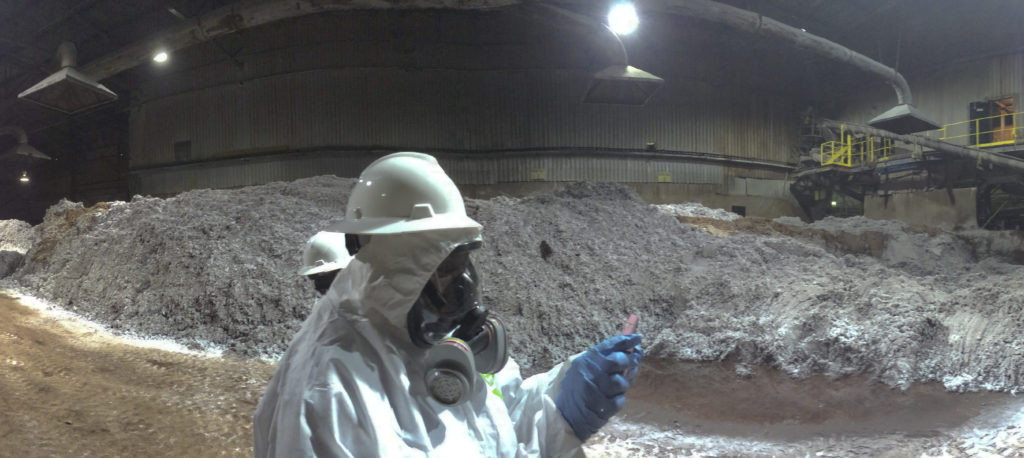Latest News
Why Is It Taking So Long to Clean Up L.A.’s Exide Mess?
The Dept. of Toxic Substances Control has halted all field work on cleaning homes affected by Exide contamination until further notice.

It was the last evening of January, and the temperature outside the Resurrection Church meeting hall in East Los Angeles was dropping, but inside the hall the mercury climbed upwards as the hours ticked by. Many in the crowd—which consisted of impatient community members, old men with canes, government suits, workers in fluorescent-colored vests—were awaiting the moment when the officials would relinquish the microphone and let the public finally take the floor.
They were here for a California State Assembly oversight hearing on the cleanup taking place at the nearby shuttered Exide battery recycling facility, which for decades had spewed lead and arsenic contaminants into communities that are already some of the most environmentally burdened in the state. Some 100,000 people are believed to have been impacted.
As part of a quarter-billion dollar plus residential cleanup—described by government officials as the largest, most complex such project the state has undertaken—8,555 homes have been sampled within a 1.7-mile radius around the plant. Some 3,200 of the most impacted properties were expected to be cleaned by June of 2021. But the first contaminated homes were remediated in 2014, and more than five years later, only 1,754 properties have been cleaned. What’s more, a current lack of funding means there’s still no concrete plan to remediate another 4,700-plus homes contaminated above a state soil lead screening level.
The Parsons Corp. has been charging taxpayers a 57 percent markup per home during the Exide cleanup.
Today’s seismic disruptions from the spread of COVID-19 have pushed the project back even further. The Department of Toxic Substances Control (DTSC)—the state agency overseeing the residential remediation—recently suspended all field work on the residential cleanup “until further notice,” according to an agency spokesperson. The protracted timeline begs this question: Why is the project taking so long?
Capital & Main has reviewed documents obtained through public record requests, solicitation of companies and other agencies involved in the cleanup, as well as information available online. This review uncovered a cleanup history marked by confusion and shifting goalposts, missed deadlines and ballooning budgets. Among our findings:
- Under DTSC’s supervision, the cleanup of lead-contaminated soil has run over budget and fallen years behind original schedules.
- Negotiations conducted in 2017 and 2018 between DTSC and potential contractors to clean 2,500 homes were beset with confusion, in large part because the DTSC set highly irregular bond requirements. The months-long negotiations fell apart, pushing the cleanup even further back.
- The Parsons Corp., one of the companies eventually awarded a cleanup contract, has been charging taxpayers a 57 percent markup per home above what had been agreed upon with the state.
Though work on the residential cleanup has accelerated over the past year, experts have long warned about the human health impacts involved with prolonged exposure to the contamination around the former Exide facility. Lead is a potent neurotoxin and probable carcinogen known to cause high blood pressure and heart and kidney disease. There’s no safe level of exposure in children, according to the World Health Organization.
Throughout the ongoing cleanup, goals have been set and repeatedly missed.
This helps to explain why many among the largely Latino, working-class communities surrounding Exide have voiced concern with the cleanup’s direction. Indeed, California’s state auditor recently agreed to investigate the project.
These fears spilled over inside the Resurrection Church meeting hall when the public finally had its say. “Something needs to be done,” Yvonne Watson, chair of the Sierra Club Angeles Chapter Environmental Justice Committee, pleaded with the assembled politicians and government officials. “Something needs to be done right away.”
The First $176.6 million
Throughout the ongoing cleanup, goals have been set and repeatedly missed. For example, when in 2016 then-Gov. Jerry Brown first earmarked $176.6 million of general fund money for the cleanup, it was with the caveat that as many as 3,000 of the most contaminated homes would be cleaned up by the end of June 2017. A full eight months after that deadline, the DTSC had cleaned only 262 properties.
Although officials had warned at the time that following state environmental review requirements would delay the cleanup by a year, Jane Williams, executive director of California Communities Against Toxics and a member of the DTSC-supported Exide Advisory Group, told Capital & Main it needn’t have delayed the timeline as much as it did. “It all comes down to project management,” she said.
Nearly two-and-a-half years after its “imminent and substantial endangerment” finding about the Exide plant, DTSC had fewer than 300 properties cleaned.
In fact, it wasn’t until September 2017 that the DTSC formally received bids to clean up approximately 2,500 “sensitive land use properties” within the 1.7-mile contamination radius. The time frame for completion was two years from when the contract would be awarded. At the end of that September, the DTSC signaled it would accept the second-lowest offer of $117.1 million from Environmental Quality Management. However, nearly a half-year later, EQM was dropped from the project after months-long negotiations were beset with confusion and crossed lines of communication, the correspondence shows.
In a February 2018 letter to EQM, the DTSC’s chief counsel, Amilia Glikman, formally terminated negotiations, blaming several contracting disputes over such things as costs and bond requirements. “DTSC has determined that EQM cannot implement a cleanup” that protects the “health of the people who live in the communities around the former Exide facility,” she wrote.
But according to EQM, the crux of the problem primarily revolved around a last-minute provision the state inserted into the original contract requiring the winning bidder to front a “performance bond” totaling 100 percent of the cleanup costs, which experts say is highly irregular.
Parsons charged on average $80,000 per home cleanup. Under its contract, its average cleanup cost per home should be no more than $51,000.
In a subsequent letter, EQM attorney Glen Sherrier excoriated the agency for “extreme ambiguity” surrounding its bond requirements, adding that the agency has attempted to award EQM an “illegal contract that differs drastically from the deal DTSC advertised many months ago.”
The DTSC forwarded the matter to the state attorney general’s office for review, the outcome of which is “privileged and confidential,” an agency spokesperson explained in an email to Capital & Main.
Endangerment finding
Nearly two-and-a-half years after an “imminent and substantial endangerment” finding it had made concerning the public health and environmental risks around Exide, the DTSC was nearly back to square one, with fewer than 300 properties cleaned.
At that point, the agency issued National Engineering and Consulting Group (NEC) an interim contract to clean up 215 sensitive land-use properties for $10.4 million. Rather than put out for public bid the contract to remediate the bulk of the remaining priority contaminated properties, the DTSC invited a select number of companies to compete for the project.
National Demolition Contractors (NDC), which had posted the lowest bid of nearly $86 million during the original bid process, was not invited to participate, said Joe Sevrean, NDC’s environmental director during those contract negotiations.
In the end, the DTSC awarded Parsons—a vast organization with a reported 15,000 employees—$82 million to clean up 1,610 homes. The contract that is posted online runs through 2020. Parsons and NEC are required to front performance bonds totaling only a fraction of the cleanup costs—numbers that are in line with typical bond requirements, say experts.
State Assemblymember: “I’m pissed like our community’s pissed.”
According to documents distributed by the DTSC during a community meeting held last December, the cleanup costs per home have markedly increased over the years, with the average cost per home that Parsons charges proving significantly more than NEC’s average. Indeed, Parsons charged on average $80,000 per home while NEC charged $65,000, according to the DTSC documents. Under the language in Parsons’ contract for the 1,610 properties, its average cleanup cost per home should be no more than $51,000.
DTSC officials have previously stated that they were in the process of renegotiating the existing contract with Parsons to cut costs. In a statement to Capital & Main at the end of February, Parsons wrote that “while we don’t comment on specific contract terms, cost-effectiveness for the areas that we serve is always a priority. We will continue working with the State to ensure accurate cost information.”
Nevertheless, a DTSC spokesperson recently explained that those negotiations have come to a halt. “We are not working on the Parsons contract negotiations nor revising the contract,” the spokesperson wrote. “When residents are willing to have work done on their properties, we will start cleanups with NEC and either revise the Parsons contract or solicit a new contract.”
“I’ve had it”
Nearly all the residential cleanup funds thus far have come out of taxpayers’ pockets. In addition to the original $176.6 million drawn from the general fund, Gov. Gavin Newsom allotted in the state budget another $74.5 million toward expediting the cleanup early last year.
The DTSC has repeatedly stated that Exide is ultimately responsible for the cost of the residential cleanup. When asked about the agency’s handling of the project, a DTSC spokesperson reaffirmed that position in an email that explained how the agency had rejected Exide’s 2019 Corrective Action report in which the company claims it is not responsible for lead levels in the surrounding community that are high enough for remediation.
Last July, the DTSC asked the U.S. Attorney’s Office to end its non-prosecution agreement with Exide, which provides that if Exide complies with DTSC’s orders on the cleanup, it will avoid federal prosecution.
Nevertheless, the likelihood of reimbursement for “anywhere near the full cost is relatively low in a case like this,” said Sean Hecht, co-executive director of the University of California, Los Angeles’ Emmett Institute on Climate Change and the Environment.
“That’s always been true, even in the best of circumstances,” Hecht said, adding that various potential sources of lead pollution in the affected communities, including lead paint and a legacy of emissions from the nearby freeways, complicate matters. “When you have mass contamination, it’s very difficult to get full compensation from the companies that are responsible.”
According to Angelo Bellomo, deputy director of the Health Protection Division at the L.A. County Department of Public Health, the cleanup’s slow rollout has resulted in ongoing risks of lead exposure for community members living near the former Exide site. “When you think about it, the negligence in the state’s prior regulation of this facility and its unwillingness to embrace innovative and rapid solutions to the cleanup is really shameful,” he said.
The latest concerns surrounding the state’s handling of the Exide cleanup also coincide with a recent Office of State Audits and Evaluations report into the agency’s broader financial operations, which listed a series of organizational flaws, including with its contracting department.
“I’ve had it,” said Assemblymember Miguel Santiago (D-Los Angeles), who publicly pushed for the new state audit focusing on the Exide cleanup. “I’m pissed like our community’s pissed.”
Copyright 2020 Capital & Main

-

 The SlickNovember 14, 2025
The SlickNovember 14, 2025Can an Imperiled Frog Stop Oil Drilling Near Denver Suburbs? Residents Hope So.
-

 Latest NewsNovember 19, 2025
Latest NewsNovember 19, 2025How Employers and Labor Groups Are Trying to Protect Workers From ICE
-

 Column - State of InequalityNovember 13, 2025
Column - State of InequalityNovember 13, 2025Barring a Sharp Shift, Health Insurance Costs Will Skyrocket
-

 Latest NewsNovember 18, 2025
Latest NewsNovember 18, 2025Future of Special Education at Risk, Teachers Say, as Trump Moves to Cut Staff and Programs
-

 The SlickNovember 18, 2025
The SlickNovember 18, 2025After Years of Sparring, Gov. Shapiro Abandons Pennsylvania’s Landmark Climate Initiative
-

 Latest NewsNovember 17, 2025
Latest NewsNovember 17, 2025In South L.A., Black and Latino Neighbors Unite Against ICE as Systems Fail
-

 Column - State of InequalityNovember 21, 2025
Column - State of InequalityNovember 21, 2025Seven Years Into Gov. Newsom’s Tenure, California’s Housing Crisis Remains Unsolved
-

 StrandedNovember 25, 2025
StrandedNovember 25, 2025‘I’m Lost in This Country’: Non-Mexicans Living Undocumented After Deportation to Mexico

